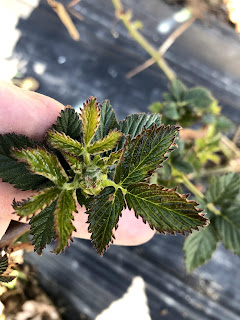Spring 2019 has been WET. But blackberry plants have broken
bud are ready to start the season throughout the regoin. Chores and timing may
be somewhat different in your area or for your cropping system.
For IPM recommendations and general production practices,
see the 2019 Southeast Regional Caneberry Integrated Management Guide.
The SRSFC production practices are in the Regional Caneberry
Production guide (includes link to PDF format):
·
https://content.ces.ncsu.edu/southeast-regional-caneberry-production-guide
Crop phenology for IPM
The IPM
guide above lists these stages of growth or planting age. This is the time of
year we are now leaving (or have left a while ago!) the dormant period and by
the time the next newsletter comes out, we will likely be harvesting in some
locations.
·
Dormant (prior to budbreak)
·
Delayed dormant (swollen buds) to green tip
·
Shoots 6 inches long and before blooms open
·
Pre-bloom (when flower buds show white)
·
Early bloom (5-10%)
·
Full Petal
·
Cover sprays
·
Pre-harvest (14 days before anticipated harvest)
·
Harvest
Plant growth and
development during the spring/summer
·
Plants deacclimate quickly
·
Bud differentiation (additional flowers can be formed)
·
Bud break
·
Flowering
·
Primocane emergence
Pruning and trellising
·
Finish pruning and make sure all floricanes are
tied to the trellis before budbreak
·
Remove canes from field to minimize spread of
diseases
·
Rotate shift trellises to horizontal position
before budbreak; rotate to upright position immediately after flowering.
Weeds
·
Weed growth can be very vigorous at the same time
as the bramble crop peaks
·
Weed control is best done earlier in the season,
with pre-emergent herbicides before harvest commences
·
Hand-weed perennial weeds in and around plots
Insect, disease and
crop ripening
·
Growers with a history of cane diseases and/or
mites often find that certain fungicides and oils are most effective just prior
to bud break. The period of time in the spring when the plant is flowering is
the most important season for control of insects and diseases. Know what your
pests are and how to control them.
Water management
·
Test irrigation system and look for leaks
·
Caneberry plants need about 1”-2” water/week.
This amount will be especially critical during harvest
Fertility management See
Caneberry Production Guide
Marketing and miscellaneous
·
Service and clean coolers
·
Make sure you have enough containers for fruit
in the coming season
·
Prepare advertising and signage for your stand
·
Contact buyers to finalize orders
·
Hire pickers
·
Prepare signage for field orientation; it is
easier to tell pickers where to go if rows are numbered
·
Monitor and record peak flowering date for each
variety every year. Then later during harvest, check your records for peak
harvest of each variety. Over time, it
will help you to determine when your peak harvest will occur.




